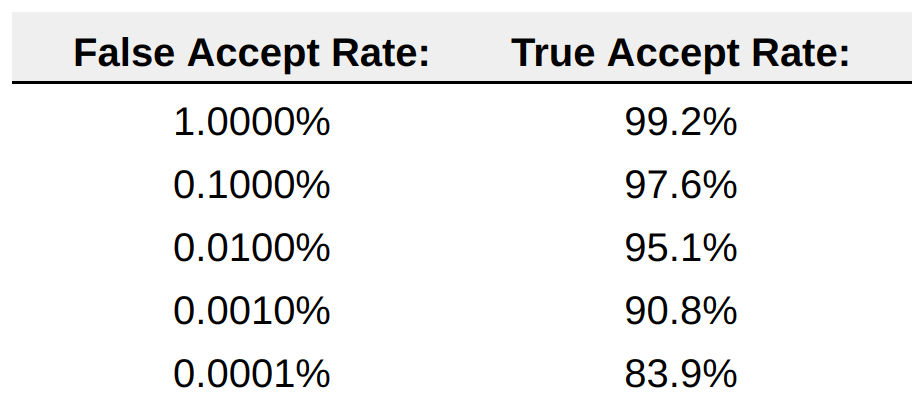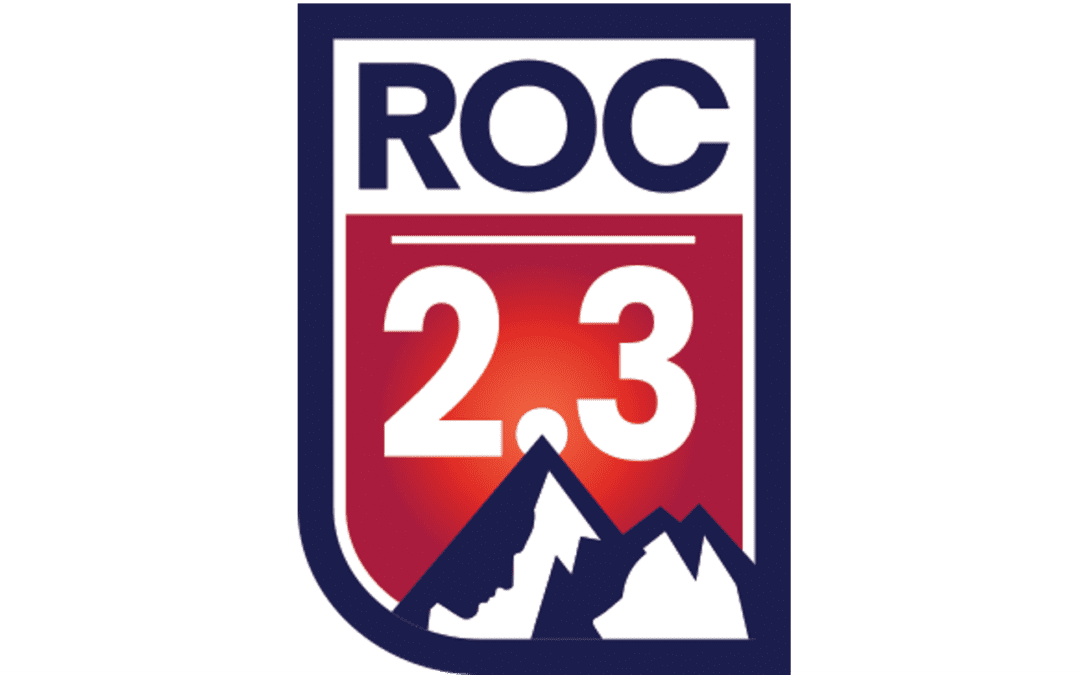- Liveness / Presentation Attack Detection (PAD)
- Tattoo Recognition
- Facial Analytics
- License Plate Detection
Liveness / Presentation Attack Detection (PAD)
Perhaps the most consequential improvement with v2.3 is a major reduction in error rates to ROC’s patented, single-frame, passive liveness algorithm. Rank One’s investment in liveness capabilities has yielded substantial improvements over the last year, building on the recent improvements in our previous v2.2 release.
The liveness solution currently ships with two different suggested operational thresholds: Security and Convenience. Convenience mode is primarily relevant to continuous authentication applications that need to be as frictionless as possible. Security mode is primarily relevant to single authentications related to sensitive systems and assets, such as identity proofing.
The following improvements have been delivered to the ROC SDK v2.3 Liveness solution:
 Liveness error rate comparison between ROC SDK v2.2 and v2.3
Liveness error rate comparison between ROC SDK v2.2 and v2.3
The provided error rates are measured on a large corpus of images that span all the Level A spoofing attacks as defined by the FIDO Alliance and in accordance with the ISO 30107-3 testing standard. The Genuine Reject Rate, which is referred to as the Bona Fide Presentation Classification Error Rate (BPCER) in the ISO standard, is when a genuine user’s presentation to a camera is incorrectly flagged as a potential spoof presentation. The Spoof Accept Rate, which is referred to as the Attack Presentation Classification Error Rate (APCER) in the ISO standard, is when a spoof presentation is incorrectly accepted as a genuine user presentation.
As shown in the above results, the ROC Liveness solution now provides the ability to severely limit spoof attacks while keeping the acceptance of genuine samples within the standards-compliant range. ROC will be eagerly submitting to the forthcoming NIST FRVT PAD benchmark. Through these improvements ROC will become certified as fully compliant with all applicable standards and industry best practices for facial biometric presentation attack detection.
Beyond single frame passive liveness, ROC further provides a suite of capabilities to support digital identity verification. This includes a wide range of facial analytics in support of ICAO and ISO standards. ROC offers easy to integrate “LiveScan” capabilities that allow ROC partners to easily capture a single, standards-compliant facial image for a user presenting themselves to a camera, with or without an active internet connection.
Another round of enhancements to ROC Liveness will be on the way at the start of 2023.
Tattoo Recognition
Rank One is a leading provider of tattoo recognition technology, with our algorithms deployed domestically and internationally within various law enforcement agencies. This capability is primarily used by law enforcement agencies with large databases of tattoo images captured at arrest booking to perform tasks such as identifying deceased victims who have little information available for identification aside from their tattoos.
In the latest version of ROC’s tattoo algorithm, a major improvement enables the ability to accurately detect, localize, and represent tattoos images in a compact feature vector representation. Through the implementation of best practices in deeply convolved neural network representations of localized tattoo regions, ROC has now achieved drastically higher accuracy.
When evaluating 1:1 comparison accuracy for the ROC tattoo algorithm, which allows for easy generalization to the true 1:N use-case, the ROC tattoo algorithm achieves robust performance on this challenging problem:
 ROC v2.3 Tattoo Recognition Accuracy Results
ROC v2.3 Tattoo Recognition Accuracy Results
Such recognition accuracies are quite powerful, especially when compared to the last published NIST Tatt-E report. While NIST Tatt-E is not currently accepting new submissions, accuracy comparisons of the top performing submission in the NIST Tatt-E report to ROC Tattoo v2.3 confirm that the ROC algorithm is significantly more accurate.
NIST Tatt-E primarily measured accuracy as Rank-10 retrieval rate on a gallery of 100,000 images. In this manner, the most accurate solution achieved a hit rate of 72.1% in that report. While not directly comparable, True Accept Rate at a False Accept Rate of 1 in 100,000 (0.001%) would serve as a lower bound for Rank-1 accuracy on a gallery of size 100k in cases where there is only one sample per identity.
By comparison, when the ROC algorithm is measured at a False Accept Rate of 0.001%, a True Accept Rate of 90.8% is achieved. Thus, increasing the challenge from being a Rank-10 match to a Rank-1 match, ROC (90.8%) still outperforms the industry leading solution (72.1%) by a wide margin. Such a clear separation in recognition accuracy demonstrates that the new ROC Tattoo algorithm is likely the most accurate solution in the world (and by a wide margin).
Accuracy is not the only thing setting the ROC tattoo algorithm apart from participants in the NIST-C report.
 ROC v2.3 Tattoo Recognition Accuracy Metrics on a single a x64 CPU Core
ROC v2.3 Tattoo Recognition Accuracy Metrics on a single a x64 CPU Core
As shown in the above table, the ROC Tattoo algorithm is incredibly fast and efficient. By comparison, in the NIST Tatt-E report the most accurate algorithm required 75.8 seconds to conduct a single search of a 100k image dataset. ROC can do this in less than 350 milliseconds. In other words, the ROC tattoo algorithm is not just the most accurate tattoo algorithm, it is also over 100x faster than the previously most accurate solution! Even the fastest solution submitted to NIST required 2.0 seconds to conduct the same search despite being far less accurate than other algorithms in that report.
In addition to the quantitative results of this new algorithm, the algorithm’s qualitative performance is arguably more impressive. While privacy reasons prevent us from showing operational tattoo images, top retrieval candidates generally have highly visual similarity to the probe candidate images. Such results make it immediately clear that this next-gen tattoo recognition capability will be a game-changer for forensic investigators in terms of the ability to find the same or highly similar tattoos to one in question.
Facial Analytics
As opposed to face recognition which is purely based on the identity of a person contained in an image, facial analytics provide ancillary information regarding the presented face.
Rank One has been an industry leader for many years in automated facial analytics, powering use-cases ranging from age verification, to LiveScan face acquisition for passenger travel, retail analytics, and many more.
To address the rising demand for ROC Facial Analytics for deployment across a wide range of hardware architectures and software systems, the ROC SDK v2.3 delivers a complete overhaul of our analytics algorithms. All facial analytics can now be generated without first computing a facial recognition template. Through this change our full suite of facial analytics algorithms can be extracted in roughly 50ms total on a single CPU thread. These analytics include:
- Age
- Gender
- Geographic Origin
- Emotion
- Facial pose
- Glasses
- Mask
- Eyes Visible
- Occlusion
- Facial Hair
In addition to the speed improvements from this new facial analytics method, it also delivers accuracy improvements to a majority of these different analytics methods.
Finally, we added one new facial analytic feature to this release: the ability to remove the background from a facial photograph. In turn, the background of the photograph can be set to a consistent color in order to adhere to various compliance standards such as ISO/IEC 19794-5 and ICAO 9303.
License Plate Detection
The final algorithmic improvement in ROC SDK v2.3 is a significant increase in accuracy for our license plate detection algorithm. This license plate detector is primarily used with ROC’s overall License Plate Recognition (LPR) solution.
Coming on the heels of the LPR improvements in v2.2, ROC is quickly developing broad capabilities in a range of use-cases for LPR technology.
—
Contact us today to learn more about ROC SDK v2.3!
